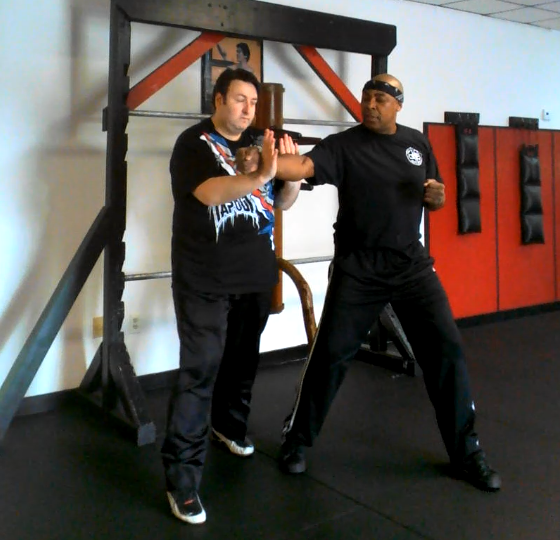Exploring the Use of Locks in Wing Chun
By Maurice Novoa a master under the Yuen Kay Shan, Ip Man and Pan Nam lineages.
Introduction:
Wing Chun, a Chinese martial art known for its practical and efficient techniques, encompasses a range of combat strategies that extend beyond strikes and kicks. While locks are not the primary focus of, the art does incorporate certain principles and techniques that can be utilized for controlling an opponent. In this article, we will delve into the subject of locks in Wing Chun and shed light on their application within the system.
Focus on Efficiency and Simplicity
Wing Chun emphasizes direct and efficient methods to neutralize opponents, focusing on close-range combat. The art’s core principles revolve around simultaneous attack and defense, quick and economical movements, and exploiting an opponent’s vulnerabilities. Although locks are not the central aspect, the art offers strategies to control an opponent’s movements effectively.
The Concept of “Sticking Hands” (Chi Sao)
One of the key training methods in Wing Chun is Chi Sao, also known as “sticking hands.” Chi Sao serves as a bridge between techniques practiced in a controlled environment and their practical application in real combat. During Chi Sao training, practitioners develop sensitivity, reflexes, and the ability to maintain contact with their opponent.
Joint Manipulation Techniques
While Wing Chun primarily focuses on strikes and efficient movement, certain joint manipulation techniques can be integrated into the system. These techniques leverage positioning, angles, and the opponent’s structure to gain control and disrupt their balance. Joint locks, such as wrist locks or arm bars, can be used in specific situations to immobilize an opponent temporarily.
Application of Locks in Self-Defense Scenarios
In self-defense scenarios, the application of locks in Wing Chun can be situational and opportunistic. When faced with an opponent’s grab or attempted strike, a practitioner may utilize joint manipulation techniques to redirect or control the opponent’s movement. The efficiency and simplicity of the art enable practitioners to adapt and respond effectively to various situations.
A Holistic Approach to Combat
It is important to note that locks in Wing Chun are not isolated techniques but are integrated into a holistic approach to combat. Its practitioners focus on the overall flow of a fight, combining strikes, kicks, footwork, and positioning to gain an advantage. Locks serve as additional tools within the system, complementing the art’s principles and strategies.
Arm Breaks: Control and Devastation in Wing Chun
Wing Chun, the renowned Chinese martial art known for its efficiency and practicality, encompasses a range of techniques designed to overcome opponents. Among these techniques, arm breaks hold a significant position, offering both control and devastating potential. In this section, we will delve into the role of arm breaks in Wing Chun, highlighting their capacity for control while acknowledging their destructive nature.
Arm Breaks: A Double-Edged Sword
Arm breaks in Wing Chun are powerful techniques that leverage joint manipulation and precise targeting to immobilize an opponent’s arm. While the primary intent of arm breaks is to inflict severe damage and disable an adversary, they can also be used as a means of control when applied with restraint and precision.
Joint Manipulation and Structure Disruption
The practitioners employ joint manipulation to exploit the vulnerabilities inherent in an opponent’s structure. By utilizing leverage, positioning, and sudden force, Wing Chun exponents can target and apply pressure to key areas of the arm, such as the elbow or wrist, resulting in excruciating pain and potential fracture.
Control through Arm Breaks
While the destructive potential of arm breaks is undeniable, skilled Wing Chun practitioners can modulate the application of these techniques to exercise control over an opponent. By applying just enough pressure to create discomfort and enforce compliance, rather than causing a complete fracture, the practitioner can neutralize the opponent’s offensive capabilities without causing irreversible damage.
Timing, Precision, and Sensitivity
The successful execution of arm breaks in Wing Chun relies on precise timing, exceptional sensitivity, and the ability to read an opponent’s movements. Practitioners develop these skills through extensive training in techniques such as Chi Sao (sticking hands), which enhances tactile sensitivity and reflexes. This heightened awareness allows the practitioner to seize opportunities for arm breaks during dynamic exchanges.
The Moral and Ethical Consideration
The use of arm breaks in Wing Chun, like any martial art technique, carries moral and ethical considerations. Practitioners are encouraged to exercise responsibility and restraint, employing arm breaks only in situations that necessitate self-defense. The focus remains on self-preservation and ensuring the safety of oneself and others, rather than causing unnecessary harm.
Conclusion
Arm breaks, a significant component of Wing Chun, exemplify the art’s effectiveness in combat situations. While their primary purpose is to disable and incapacitate opponents, arm breaks can also be employed with control, allowing for manipulation and restraint when needed. Wing Chun’s emphasis on timing, precision, and sensitivity enables practitioners to execute these techniques effectively while maintaining a strong sense of moral responsibility.
Through dedicated training and a deep understanding of the principles and applications of arm breaks, Wing Chun practitioners can harness the power of these techniques, balancing control and devastation in their martial arts practice.
While Wing Chun primarily emphasizes strikes, kicks, and efficient movement, the art does incorporate principles and techniques that can be utilized for joint manipulation and control. Although locks are not the central focus of Wing Chun, joint manipulation techniques can be integrated into the system to enhance a practitioner’s ability to control an opponent’s movements.
The effectiveness of locks in Wing Chun relies on the practitioner’s understanding of timing, positioning, and sensitivity developed through consistent training and application. By incorporating these principles into their practice, practitioners can enhance their overall combat skills and adaptability in self-defense situations.

